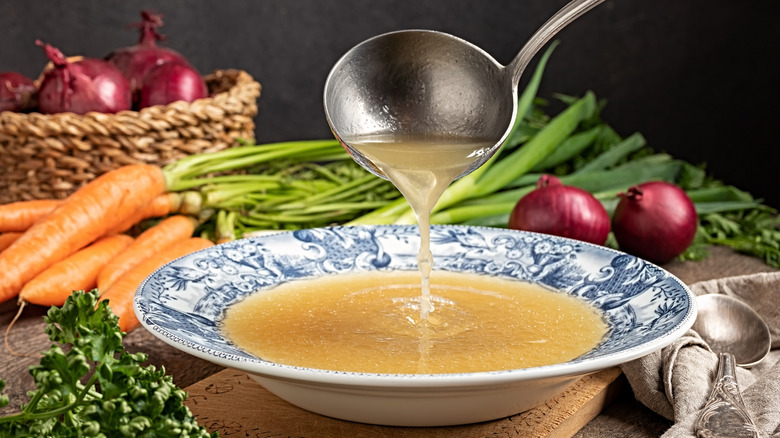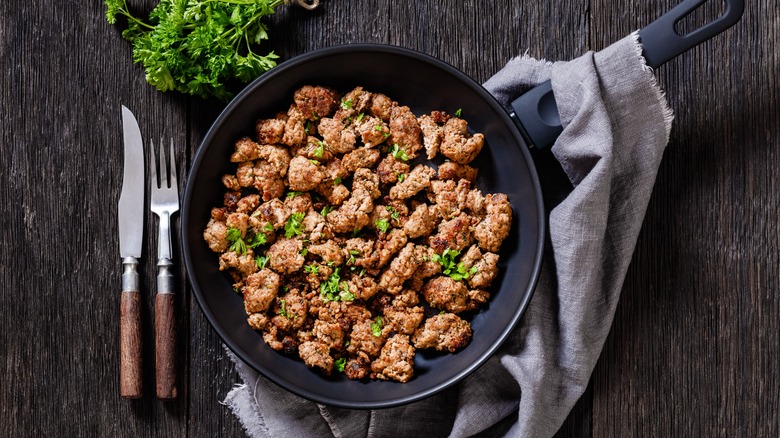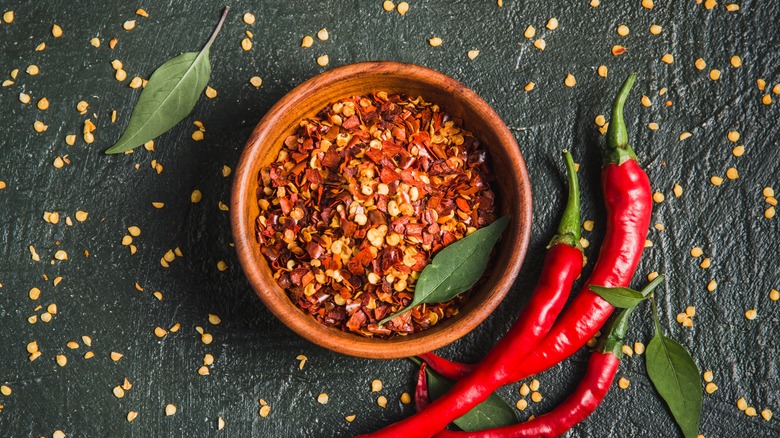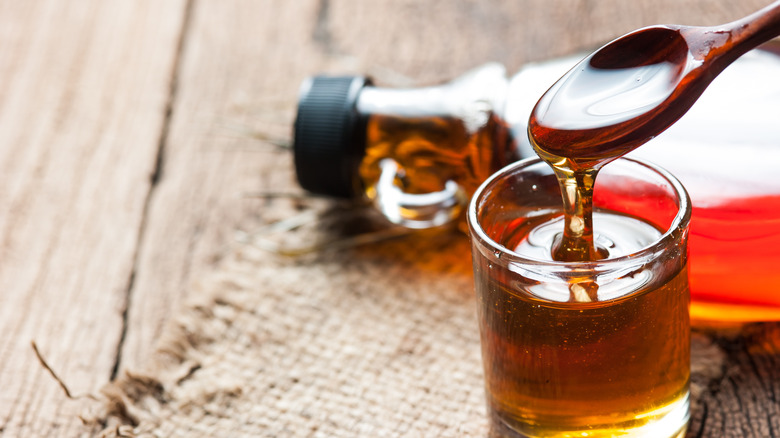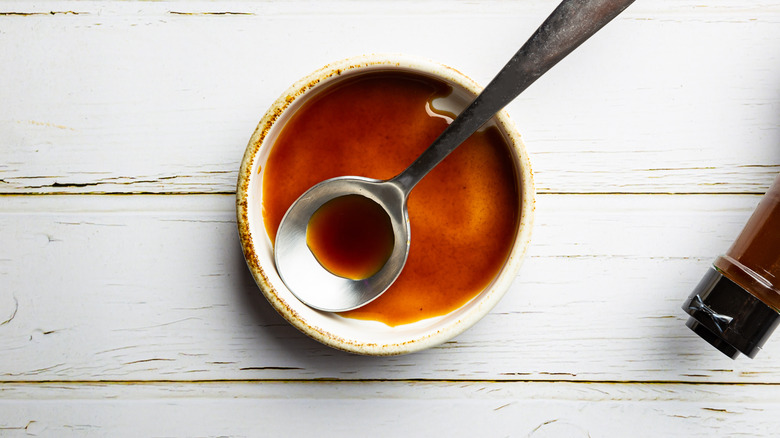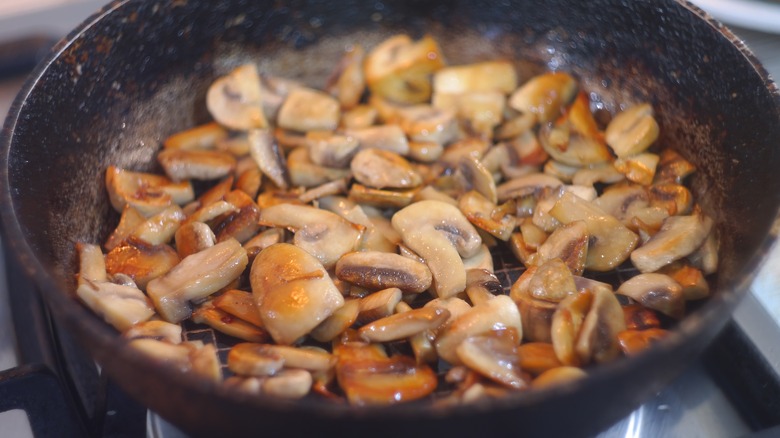12 Tips That Will Elevate Your Sausage Gravy
A steaming plate of fluffy biscuits smothered in sausage gravy is a beautiful thing. Occasionally referred to as "sawmill gravy" due to its history of nourishing-working class sawmill laborers in the mountains of Southern Appalachia, this dish has evolved from its humble roots to become a national treasure, simmering on stove tops in fancy brunch joints and residential kitchens all across the country. It's easy to understand why biscuits with sausage gravy are so popular: Not only is this dish filling and packed full of flavor; it's also fairly affordable and easy to make.
Of course, there's always room for improvement. That's the beauty of cooking — there's always more to learn, and you get to immediately enjoy the fruits of your labor. So whether you're a seasoned vet who's been riding the sausage gravy train for a lifetime or a curious newcomer looking to level up your breakfast repertoire, there are lots of little tricks to enhancing this beloved Southern staple.
1. Homemade sausage
Sure, you could always score some store-bought sausage. And while the store-bought stuff is convenient and undeniably tasty, the truth is that making homemade sausage will create a gravy that tastes light-years better — and that's why we're all here, right? The good news is that making pork sausage doesn't really require all that much time or effort. Because this is being used in gravy, there's no need to go through the trouble of stuffing the sausage into a casing. All you need to do is season some ground pork to your liking.
When it comes to the ground pork, you have a couple of options. You could simply buy some pre-ground pork from your local butcher or grocery store and then season it, which will save a little time. Or, if you have a meat grinder, you can go the extra mile and grind up the pork yourself. Your effort will reward you with a level of freshness that will make your sausage exceptionally tender.
Another major advantage here is that by making the sausage yourself, you're in complete control of the seasoning. If you like your sausage heavy on the sage, you can make it extra herbaceous. If you're trying to cut back on the salt, you can measure it out and lightly season the pork. You get the idea: When you're making your own sausage, plain ground pork is basically a blank canvas. Controlling the taste of the sausage gives you more control over the taste of the gravy.
2. Homemade chicken broth
Another easy trick that will inject some seriously impressive flavor into your sausage gravy is using homemade chicken broth. When it comes to liquid ingredients for sausage gravy, lots of recipes only call for milk — but milk by itself isn't exactly wildly flavorful. Milk adds the velvety creaminess we're looking for, so it's still very much necessary for a good sausage gravy — but adding in some chicken broth along the way will really amp up the flavor. And rather than buying it from the store, you can really knock it out of the park and make your own chicken broth from some homemade chicken stock.
Once you've cooked the sausage, deglaze the pan with your fresh chicken broth first before adding any milk. Deglazing will help pull up all of those little bits of sausage stuck to the bottom of the pan and incorporate all of that flavor back into the gravy. And because you're using a homemade chicken broth to deglaze the pan, the flavor from deglazing will be even more concentrated and delicious. Another important point: Much like seasoning your own sausage, making your own chicken broth puts you in complete control of the flavor. The precise levels of salt and pepper, along with any herbs and spices, are totally in your hands, which allows you to add extra depth to your gravy.
3. Fresh herbs
While dried herbs are the practical choice due to their long shelf life and versatility, they also taste less fresh compared to, well, fresh herbs. A simple way to add some extra oomph to your sausage gravy is to swap out the dried herbs with fresh ones. Note: It's important to stay mindful of the difference between dried and fresh herbs. Dried herbs have a more concentrated flavor than fresh herbs — in general, a teaspoon of dried herbs is roughly the equivalent of a tablespoon of fresh herbs. All this really means is that you'll have to use more fresh herbs to maximize their herbaceousness — but using fresh herbs will pay off big time by adding a layer of flavorful complexity that dried herbs just can't compete with.
So, what fresh herbs should you use? Fresh sage is always a great choice when it comes to sausage. Sage has a woody, almost musky flavor that pairs with sausage exceptionally well. Fresh thyme is another wise choice. Thyme has a distinctive taste that's earthy and lemony with a hint of pepper that works wonders in pork sausage. Using fresh herbs like sage and thyme will fortify your gravy with a lovely aroma and a brightness of flavor that's far superior to anything you can achieve with the dried stuff.
4. Let the sausage brown in the pan
Browning your sausage in the pan may seem obvious, but it's a step that can be easily overlooked. Just to be clear, there is a big difference between cooking your sausage and actually browning it. Browning your sausage entails letting the pork cook until a light crust forms on the meat, creating a beautiful golden-brown color that's induced by the Maillard reaction. Browning creates a deeper, nuttier flavor that's tastier and more complex.
Browning is very easy to achieve. All you really need to do is make sure your pan is nice and hot before you add the sausage — you want to hear the sausage sizzle the moment it hits the pan. Of course, you don't want to go too far and let the sausage burn, so make sure that your timing is right and that the heat is set to an appropriate level. Once the sausage is sizzling in the pan, you may be tempted to start chopping it all up right away, but you need to resist that impulse. Patience is key. If you start immediately mixing up the sausage, the meat won't have a chance to brown thoroughly. By letting the surface of the sausage remain in contact with the heat of the pan, you are allowing the meat enough time to develop browning. And browning creates a much richer flavor that will carry over into your gravy.
5. Keep the sausage chunky
Before you start cooking your gravy, ask yourself this question: About how big do you want your chunks of sausage to be? It's easy to get locked into auto-pilot mode and get carried away mincing it up in the pan into minuscule pieces — but do you really want the sausage to get pulverized into nearly microscopic, sand-like particles? Chopping up your sausage too much will make it impossible for you to truly sink your teeth into a solid bite that lets you experience its tasty juiciness. But beyond that, breaking the sausage down into tiny grains of meat can give the gravy an unpleasant, gritty texture.
All you really need to do here is be mindful of how big your pieces of sausage are as you cook it and chop it up. Of course, it doesn't have to be uniformly perfect — there are bound to be some smaller pieces that break off during the cooking process. But in general, try and aim for bite-sized pieces. By making sure that your sausage is still chunky, you're ensuring that you can really enjoy its taste — and you're also giving your gravy more texture.
6. Spice it up
Another fantastic way to kick your sausage gravy up a notch is by adding a touch of heat. Adding a little spicy kick to your sausage gravy can boost its complexity in an impressive way. Keep in mind here that you don't have to use a heavy hand — even just a small sprinkle of dried chili flakes can add major flavor. In order to unlock the natural smokiness and spiciness from the dried chili pepper flakes, make sure to add them while the sausage is cooking so that they can mingle with the pork and soak into the meat. You could also just add some dried chili flakes directly to your seasoning blend of salt, herbs, and spices if you choose to make your own breakfast sausage for this dish.
Another option is just adding a few splashes of your favorite hot sauce to the gravy. Because hot sauce often contains some vinegar, you'll get the added benefit of chili pepper flavors plus a touch of acidity. Just like with the dried chili flakes, you could also just opt to add some hot sauce to the plain raw ground pork directly during the seasoning process. No matter which method you choose, adding a little sparkle of spice to your gravy is a great way to improve the flavor.
7. Maple syrup
If you end up adding some heat to your sausage gravy, there's no better way to balance out the spice than with a little kiss of sweetness — and maple syrup is a perfect way to accomplish that. Maple syrup is a luscious mix of liquid gold flavor that introduces notes of caramel, vanilla, and an earthy nuttiness that can veer into almost prune-like territory. Try to score yourself some pure maple syrup, rather than the fake stuff. Pure maple syrup is a bit thinner and sweeter than the artificial kind — and it also brings more complexity to the table in terms of flavor.
There are different ways you can approach incorporating maple syrup into the mix. You can drizzle some straight over the raw ground pork during the seasoning process to directly flavor the meat. A word of caution here: Too much maple syrup may cause the pork to burn if the heat is too high, since there's so much natural sugar in it. To give you an idea of how much sugar we're talking about, consider the fact that ⅓ cup of maple syrup contains a whopping 60 grams of sugar. So if you choose to add some to your raw pork, it's probably best to just add a light drizzle for some subtle flavoring, since you don't want it to be overly sweet or burn in the pan. Later on, after your sausage is cooked and your gravy is simmering, you can always taste the gravy and add a little more you need to.
8. Worcestershire sauce
You'd be hard-pressed to find a sauce with a more concentrated flavor than Worcestershire. Typically made with a potent blend of ingredients that includes soy sauce, vinegar, and anchovies, Worcestershire also features notes of molasses and tamarind. The end result is a wildly robust concoction that packs major flavor even in just a single drop.
When you think of Worcestershire sauce, it probably calls to mind marinades for hearty beef dishes or even a classic Caesar salad dressing. Adding some Worcestershire sauce to your sausage gravy may seem a bit unconventional, but the truth is that it introduces a deep flavor to the gravy that intensifies its richness. Rather than adding Worcestershire sauce directly to the spiced pork, we'd recommend a drizzle directly into the gravy toward the end of the cooking process. That way, you don't risk making the gravy too salty, since the gravy's flavor intensifies as it thickens. Just keep in mind that a little goes a long way with this stuff, so it's wise to use it sparingly — and be sure to always give it a taste along the way.
9. Mushrooms and onions
Most of the flavor from sausage gravy comes from the seasoned pork, but that doesn't mean you shouldn't expand your horizons to include other proteins and vegetables. One easy trick to amping up the flavor of your sausage gravy is including sautéed mushrooms and caramelized onions.
Sautéed mushrooms add another layer of earthy richness to the dish that really elevates the flavor profile. It really doesn't require much time or effort, either. All you have to do is simply sauté fresh mushrooms with some olive oil, salt, pepper, and butter. For this dish, we'd recommend dicing the mushrooms so that they blend more seamlessly with the chopped sausage. Not only will the mushrooms add more depth of flavor to your sausage gravy, but they will also nourish you with extra protein, fiber, and antioxidants.
Caramelized onions are another simple, affordable way to boost your sausage gravy. Slowly cook your diced onions until they are golden brown and almost jammy, and then deglaze the hot pan with a splash of balsamic vinegar and stir to combine. The balsamic vinegar will add a delicious layer of richness to the caramelized onions and deepen their flavor. Once the caramelized onions have been deglazed, mix them into your sausage gravy toward the end of the cooking process. The combination of sautéed mushrooms and caramelized onions will add an abundance of flavor to the mix, dramatically improving your sausage gravy.
10. Achieve the proper consistency
This one might seem obvious, but the reality is that achieving the proper consistency for your sausage gravy is half the battle here. Let's face it: No one likes a sausage gravy that's thin and runny. If the gravy is too liquefied, it won't be able to fully cling to the biscuits or whatever else you're going to pour it over. At the same time, if the gravy is too thick and pasty, that's not exactly desirable, either. What we're looking for is a happy medium between these extremes — a sausage gravy that's bulky enough to adhere to other ingredients on the plate, but also thin enough to be easily drizzled.
You can achieve the proper consistency with minimal effort — all you really need to do is keep a close eye on the gravy and adjust accordingly. If the gravy is too thick, you can add more milk or chicken broth. If the gravy is too thin, take the time to let it simmer and reduce a bit more. It's important to keep in mind that the sausage gravy will thicken as it cools after it's finished cooking, so it's probably best to stop simmering when it's just a touch thinner than you'd like.
11. Cornstarch
Cornstarch is a highly versatile ingredient that's always great to keep on hand in your kitchen. It can be used to crisp up fried foods to crunchy perfection and soften baked goods, as well as in stir-fry marinades with proteins like chicken or beef to create a luscious, velvety texture. But cornstarch's seemingly endless uses don't stop there: It's also a fantastic way to easily thicken up glazes, sauces, and gravies.
If your sausage gravy is still too thin and you're having trouble thickening it up, using some cornstarch is a great option that can swoop in to save the day. What's most important here is to make a slurry out of it by mixing it with a little water first, until it's a milk-like consistency. Mixing the cornstarch into a slurry will help it smoothly incorporate into your gravy. If you try to cut corners and just dump the cornstarch powder in without making it into a slurry, you will be punished with a ton of clumps that need to be thoroughly whisked. Once you make your cornstarch slurry, drizzle it into your sausage gravy and continue simmering over low heat. You should immediately notice the gravy thicken after just a few minutes.
12. Garnish
As delicious as sausage gravy is, the truth is that it's not exactly known for being the most colorful dish in the world. Because it's so creamy, sausage gravy tends to be extremely pale and milky looking. Garnishing your sausage gravy will add some much-needed visual appeal. With just a few simple ingredients, you can introduce some bright colors to the dish when it's plated up that will make it even more visually enticing and appetizing.
One easy way to add some brightness to sausage gravy is by sprinkling it with paprika. Paprika's crimson color brings a warm hue to sausage gravy that really helps it shine, and it also has a mellow flavor that won't interfere with or overpower the taste of the gravy. Once you've sprinkled some paprika over the gravy, you can also garnish it with some fresh herbs like diced parsley, sage, and thyme. To add even more greenery, try chopping up some green onions and sprinkling them on top. By garnishing with paprika, fresh herbs, and green onions, your sausage gravy will take on a vibrant appearance that's bound to elevate its presentation — all while introducing even more layers of fresh flavors.


